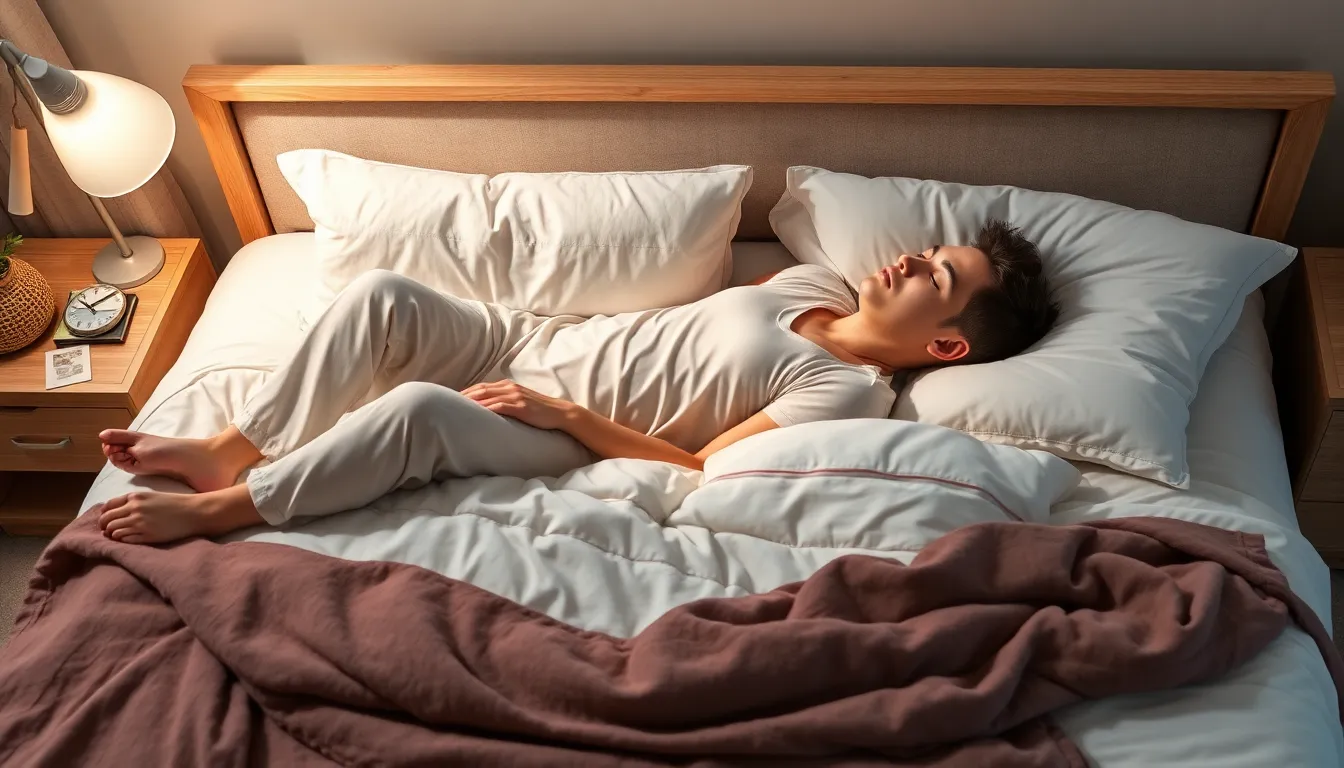Finding the right sleep position can transform a restless night into a rejuvenating slumber. With so many options available, it’s essential to understand how each position affects overall health and well-being. Whether someone prefers sleeping on their back, side, or stomach, the choice can impact everything from spinal alignment to snoring.
In this exploration of the best sleep positions, readers will discover how to enhance their sleep quality and wake up refreshed. By considering factors like comfort and potential health benefits, individuals can make informed decisions that lead to better rest. Let’s dive into the world of sleep positions and unlock the secrets to a more restful night.
Table of Contents
ToggleUnderstanding Sleep Positions
Sleep positions play a crucial role in determining sleep quality and overall health. The way one sleeps can affect spinal alignment, comfort, and even factors like snoring.
Importance of Sleep Positions
Choosing an ideal sleep position impacts comfort and sleep quality. Proper positioning can prevent back and neck pain, promote better spinal alignment, and reduce discomfort during rest. Various positions offer unique benefits, enabling individuals to select what best suits their needs.
How Sleep Positions Affect Health
Sleep positions influence several health aspects. Side sleeping can reduce snoring and alleviate sleep apnea symptoms. Back sleeping tends to maintain spinal alignment but may increase the risk of snoring. Stomach sleeping often leads to neck strain and discomfort. Understanding these effects allows individuals to make informed choices, improving sleep quality and overall well-being.
The Best Sleep Positions

Choosing the right sleep position plays a critical role in enhancing sleep quality and overall health. Each position has unique benefits and drawbacks that can significantly impact comfort and well-being.
Back Sleeping
Back sleeping supports spinal alignment. This position allows the head, neck, and spine to rest in a neutral posture, reducing the risk of pain in these areas. Back sleepers often experience fewer pressures on joints and muscles, which promotes a more restful sleep. However, this position may increase snoring and the risk of sleep apnea due to airway obstruction. Elevating the head with pillows can mitigate these risks while maintaining comfort.
Side Sleeping
Side sleeping is widely regarded as one of the healthiest positions. This position reduces the likelihood of snoring and alleviates symptoms of sleep apnea. Side sleepers often enjoy improved spinal alignment, particularly when using a pillow that supports the neck’s natural curve. Furthermore, this position may enhance digestion and lower the risk of acid reflux. Placing a pillow between the knees can also prevent hip and lower back discomfort.
Stomach Sleeping
Stomach sleeping generally poses several challenges. Although it may be comfortable for some, this position often leads to neck strain due to the head being turned for extended periods. Additionally, it can cause lower back discomfort since it flattens the natural curve of the spine. If one prefers stomach sleeping, using a thin pillow or none at all may help minimize strain but won’t eliminate the associated risks entirely.
Pros and Cons of Each Position
Understanding the pros and cons of each sleep position provides insight into improving sleep quality and overall health. Each position has specific benefits and drawbacks that can affect comfort and health.
Back Sleeping
Pros:
- Aligns the spine and neck for optimal support.
- Minimizes joint pressure, reducing discomfort.
- Can alleviate acid reflux when the head is slightly elevated.
Cons:
- Increases the risk of snoring and obstructive sleep apnea.
- May lead to lower back pain without proper pillow support.
- Not ideal for pregnant individuals due to pressure on blood vessels.
Side Sleeping
Pros:
- Promotes better spinal alignment, reducing back and neck pain.
- Reduces snoring and can help alleviate sleep apnea symptoms.
- Encourages better digestion and reduces heartburn.
Cons:
- May cause shoulder and hip pain due to pressure on those areas.
- Can lead to facial wrinkles over time from compression against the pillow.
- Requires a supportive knee pillow for optimal hip alignment.
Stomach Sleeping
Pros:
- Can reduce snoring by keeping airways open.
- May be comfortable for some individuals who prefer a flatter position.
- Puts strain on the neck and spine, leading to discomfort and pain.
- Increases the risk of developing nerve pain or numbness due to pressure on limbs.
- Generally considered the least healthy sleep position for long-term use.
Tips for Finding Your Best Sleep Position
Identifying a comfortable sleep position is key to improving sleep quality. Several factors, such as body shape, mattress type, and personal preference, impact the effectiveness of a sleep position.
Assessing Your Comfort
Assessing comfort involves recognizing how different sleep positions feel. Experiment with varying positions—back, side, and stomach—while paying attention to any resulting discomfort or pain. Try spending a few nights in each position to gauge which offers the most support and relaxation. Body alignment is crucial; ensure the spine maintains a natural curve without twisting or bending uncomfortably. Listen to your body; if discomfort arises, it may indicate a need for adjustment.
Using Pillows to Support Your Position
Using pillows strategically enhances sleep comfort and support. For back sleepers, placing a pillow under the knees helps maintain spinal alignment. Side sleepers benefit from a firm, supportive pillow that fills the space between the head and mattress while a knee pillow can alleviate hip and lower back pressure. Stomach sleepers should opt for a thin pillow or none at all to minimize neck strain. Adjusting pillow height and firmness can create a more tailored sleep experience, allowing for better rest and spinal support.
Finding the right sleep position is crucial for enhancing sleep quality and overall health. By understanding the benefits and drawbacks of back, side, and stomach sleeping, individuals can make informed choices that promote comfort and well-being. Prioritizing proper alignment and using supportive pillows can significantly reduce discomfort and improve rest. Ultimately, the journey to better sleep starts with paying attention to one’s body and experimenting with different positions to discover what works best. Embracing these strategies can lead to more restful nights and healthier days ahead.









